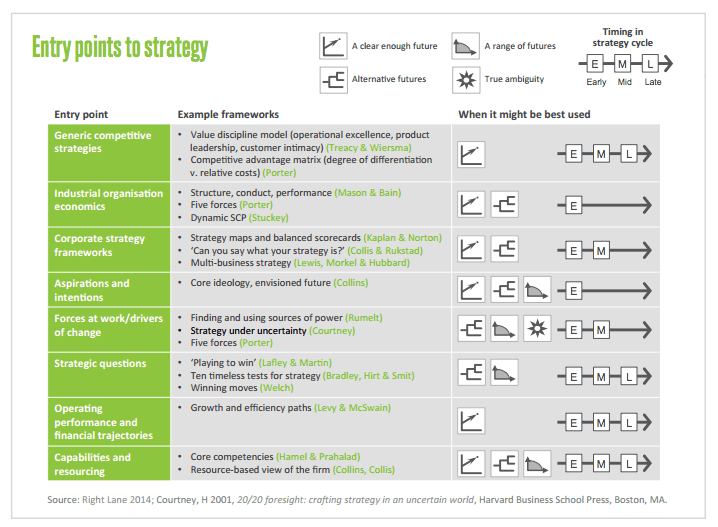Entry points to strategy
A means of engaging boards and executives in strategy development
There are numerous entry points that can be used to develop strategy and to test the robustness of strategy over time.
When deciding on which entry points to use, there are a number of factors that should be considered, including certainty of the organisation’s future, timing in the strategy cycle, and the experience and expertise of directors and executives.

By Dr Marc Levy and Brad McSwain
It is rare in business that there is the opportunity to develop a completely new strategy, from scratch. Start-ups have this advantage, but for all other organisations there will already be some form of strategy, documented or not, in place.
In Right Lane’s experience, there is no blueprint to developing or refreshing a strategy within an established organisation. Instead, we recognise that there are numerous ‘entry points’ to strategy—and that each of these will offer an opportunity to engage boards and executives on strategy in order to generate robust and progressive thinking, discussion, alignment and outcomes.
What are the possible entry points to strategy?
There are many approaches and frameworks available to develop and refine strategy. These can be broadly categorised into the following entry points:
- Generic competitive strategies allow for consideration of how to compete within a chosen market (e.g. low cost, differentiation, focus).
- Industrial organisation economics considers the broader industry in which an organisation is situated, the conduct of the major players within that industry and what that means for how to perform and succeed.
- Corporate strategy frameworks adopt structured and widely understood approaches to articulating strategy such as strategy maps and balanced scorecards.
- Aspirations and intentions engage stakeholders in thinking about and envisioning a desired future.
- Forces at work and drivers of change consider how to find and generate value within the changing internal and external environments.
- Strategic questions provide a straight-to-the-point assessment of a strategy’s completeness and robustness.
- Operating performance and financial trajectories identify and test a small number of growth or efficiency pathways, particularly useful where funding stakeholders are involved (e.g. a defined benefit super fund).
- Capabilities and the resource based view of the firm focus on an organisation’s assets and how these can be applied to deliver success.
Examples of frameworks within each of these categories is provided in the exhibit Entry points to strategy below.
Why is it important to think about entry points to strategy?
The importance of strategy to the success of an organisation is widely understood. The clear articulation of an aspiration, where and how to compete, and the capabilities and resources required to do so are all essential components of a well-designed strategy.
But how can we be confident that a well-designed strategy will also be successful? By testing the robustness of the strategy from different angles and perspectives over time, and not by using the same entry point and the same approach.
Thinking carefully about the right entry points to strategy, and using these to test and refine strategy, also has the benefit of engaging participants such as directors and executives. Their contribution of knowledge and expertise via engagement in the strategy development process will help ensure the right strategy is in place.
What factors should be considered in deciding on entry points to strategy?
Deciding how best to enter a strategy discussion will also depend on factors such as the certainty of the organisation’s future, where you are in the strategy cycle and the experience of the participants.
In 20/20 foresight: crafting strategy in an uncertain world, Hugh Courtney describes four levels of certainty, from a relatively clear future through alternative or a range of futures to true ambiguity. The most effective entry points to strategy will be influenced by the view of the organisation’s future on this spectrum. For example, corporate strategy frameworks may work best where the future is relatively clear, whereas timeless questions such as Jack Welch’s ‘what’s your winning move?’ may be suited to a more uncertain world.
The timing of the strategy review and discussion is also important when deciding on entry points to strategy. Aspirations and intentions are generally used early in the cycle, perhaps with a new CEO or in a first refresh for five years or more, and will be less suited in years two or three of a cycle. Other entry points will have a place at any time, such as generic competitive strategies and capabilities and resources.
The experiences of the board and executive must be assessed when considering the best entry points for strategy. This experience will be twofold:
- What has been seen in action and what has worked: Directors and executives will generally bring vast experience in developing strategy. They will have seen and used different approaches and frameworks and will know which of these have worked and why. Understanding these experiences can be a valuable input into deciding which entry points will engage these important stakeholders.
- The expertise of the participants: In ‘Tapping the strategic potential of boards’ (Bhagat et al, 2013) an expertise gap is put forward to explain why some directors demonstrate only limited engagement in strategy. For example only 10 percent of the directors surveyed by the authors felt that they fully understood the industry dynamics in which their companies operated and, as a result, only 21 percent of them claimed to have a complete understanding of the current strategy. Understanding such expertise gaps within a board or executive will help to understand which entry points will have the best chances of generating the necessary levels of engagement of the participants in strategy discussions.
How will you enter your next strategy review?
Many organisations take an annual approach to developing or refreshing their strategy, with involvement of the board and executive team being important to a successful process.
In Right Lane’s experience, it is critical to take the time upfront to develop a strategy process that will engage participants as well as lead to the outcomes that are suited to the current needs of the board and executive.
So, the next time you are developing or refreshing your strategy:
- Reflect on your organisation’s current situation and challenges
- Understand the levels of certainty you face and where you are in your strategy cycle
- Engage early with your board and executive to understand their expectations and gain their input
- Select the entry points that are best suited to delivering the outcomes you need now.
Want to know more?
If you would like Right Lane to help you select the entry points that are best suited to delivering the outcomes you need now, contact Marc Levy marc@rightlane.com.au
Download the Right Lane Review
References
Bhagat, C, Hirt, M & Kehoe, C 2013, Tapping the strategic potential of boards, McKinsey Quarterly, February
Courtney, H 2001, 20/20 foresight: crafting strategy in an uncertain world, Harvard Business School Press, Boston, MA

